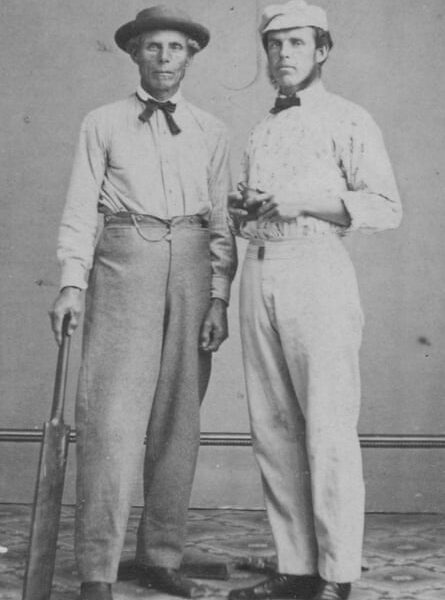Back, back, back, before anyone had invented Twenty20, before the Ashes and back beyond, before basketball had even been invented, and when baseball was still a little kids’ game, the 11 best cricketers in Toronto travelled south across the border to play a two-day game against the 11 best cricketers in the US.
It was September 1844, seven years before the first America’s Cup, 16 before the first Open championship and 33 before the first Test match. Which means Canada v USA, the opening fixture of this year’s World Cup, isn’t just the oldest international match in this sport, but, historians believe, the oldest in any sport.
The oddest detail about this already curious story is that the series, which has run for 180 years, on and off according to the state of relations between the two nations, started as a practical joke.
In the summer of 1840, a man claiming to be a Canadian player called George Phillpotts challenged the St George’s Club in New York to a match against his own Toronto CC. St George’s were, by all reports, a stuffy bunch of proud English expats who reckoned themselves the best club in the country. Their players set off north and, after the best part of a week’s travel, arrived to find that the invitation was a hoax.
Whoever that Phillpotts was, he wasn’t the man who kept wicket for TCC, who hadn’t been in New York that week, and knew nothing about the proposal. In fact the Toronto players already had an away game scheduled that weekend. But they agreed to a match against the guests anyway, since the New Yorkers had come all that way to play.
Toronto lost, but, according to the reports, everyone had a fine time regardless and the players drank “nine times nine toasts to the sons of St George, St Patrick, St David, and St Andrew”. Somewhere in the middle of this, the two teams agreed to make it an annual match.

Toronto won the return game, so the next time St George’s went north they brought three Philadelphian ringers with them. The Canadians refused to play because they insisted that only members of the two clubs were eligible. And it was during the fallout from this row that St George’s proposed the match should become a proper representative game between the best available players from all clubs on either side of the border. They issued a challenge in the press. The Torontonians accepted, and in September 1844 they travelled south to play for a stake of $1,000.
They were an odd lot, led by their champion all-rounder, David Winckworth, who was known as a “careful bat” and a “fast round-arm bowler”. He opened with John Wilson, not long out from England, who was said to be one of the “best longstop fielders in the country” because he was expert at making the long barrier with his right shin.
They also picked George Barber, who had nine fingers, who once played a single-wicket match in which he batted for two whole days without letting his opponent get to the crease; John Beverly Robinson, who would grow up to become the mayor of Toronto; an underarm bowler named Harry Maddock, who was apparently “scarcely taller than the wicket” and “always wore a black beaver hat”; and their club professional, Fred French, who was their groundsman, caretaker and cook. French was apparently renowned for his dish of “chops with tomato sauce”.
The Americans were led by Robert Tinson, a businessman who made his living selling carpets, and also picked James Turner, who scored the first recorded century on the continent when he made 120 against St George’s, and the professional player Sam Wright, who had moved over from Sheffield. Wright’s sons, Harry and George, were both professional cricketers, too, but ended up much better known for their baseball with the Cincinnati Red Stockings. Both men made the baseball Hall of Fame and Harry is still known as the “Father of the Professional Game”.
after newsletter promotion
The game was held at St George’s Manhattan home on Bloomingdale Road and, judging by the contemporary press coverage, it was all everyone who was anyone in New York was talking about. A crowd of just over 5,000 turned out, almost as many as are expected to be at Grand Prairie in Texas for the opening game of this World Cup.
Canada won the toss and batted through to mid-afternoon for 82; Winckworth, the crack bat George Sharpe and someone known only as “Freeling” made 12 each. The USA replied with 64, Tinson top-scoring with 14. The second day’s play was a washout, so everyone agreed to come back and finish things 24 hours later.
During the delay, things started to get strange. One of the umpires, who had given a controversial lbw against the Americans, vanished and the USA’s No 3 batter, George Wheatcroft, disappeared. The Weekly Herald, which reported that almost $100,000 had been wagered on the game, said “ugly rumours were afloat to account for this gentleman’s absence at such a crucial time”.
The Canadians made 63 in their second innings – Winckworth top-scoring again with a handsome 14 – and then bowled the USA out for 58 and won by 23 runs. The American players immediately challenged them to “a double or quits” game the very next day. The Canadians refused and returned home richer, resplendent with the satisfaction of beating their neighbours and entirely unaware, you guess, that their ancestors would still be at it the best part of 200 years later.
Source: theguardian.com



